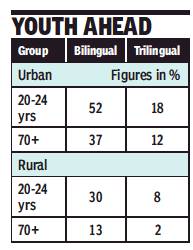Linguistic skills, ability: India
This is a collection of articles archived for the excellence of their content. |
Indians who speak more than one language
52% urban youth are bilingual, 18% speak three languages
Rema Nagarajan, November 7, 2018: The Times of India

From: Rema Nagarajan, November 7, 2018: The Times of India

From: Rema Nagarajan, November 7, 2018: The Times of India
The generation gap is showing in the number of languages Indians speak. Young Indians (age 20-24 years) are two to three times more likely to be bilingual or trilingual than their older family members. Recently released census data shows that just over a quarter of the country’s population is bilingual and 7% is trilingual. In the 1990s, less than 20% of Indians were bilingual.
The overall figure hides the huge difference between urban and rural India. While barely 22% are bilingual and just 5% trilingual in rural areas, in urban India, 44% are bilingual and 15% trilingual. The higher the age group, the lesser the proportion of people who know more than one language whether in rural or urban India. Up to the age of 14, there is no gender variation in the number of languages known. From 15 years onwards there is a significant difference in the proportion of males and females who are bilingual. This suggests that an important determinant of how many languages people know is the job market and the need to travel out of one’s home state to find a job.
India has 23 constitutionally recognised languages. With more than half the population speaking Hindi and English education spreading faster than ever, the number of multilingual people will only grow with time. Several studies have shown that multilingual exposure improves cognitive skills and social abilities. From the 20-24 age group — which is also the most multilingual — the gender gap keeps increasing with increasing age till in the 70+ age group where 25% of men are bilingual compared with just 16% of women, a difference of 9 percentage points. While the gap is not as wide for those who are trilingual, the pattern is the same, of a widening gap with increasing age.
Even within urban and rural areas, there are variations depending on the age group and gender.
Most bilingual people are in 20-24 age group
The highest proportion of bilingual people in the country is in the 20-24 age group in urban India, 52%. There is no gender difference in how many languages a person knows in urban areas till 15 years, though in rural areas the difference starts much earlier, from the 10-14 years age group, probably an indication of the number of girls who do not go to school and hence know only their mother tongue.
In urban areas, the gender gap is very small compared to the rural areas when it comes to those knowing two languages. Interestingly, the highest proportion of those who know three languages is urban men in the 50-69 age group, about 20% or one in five.